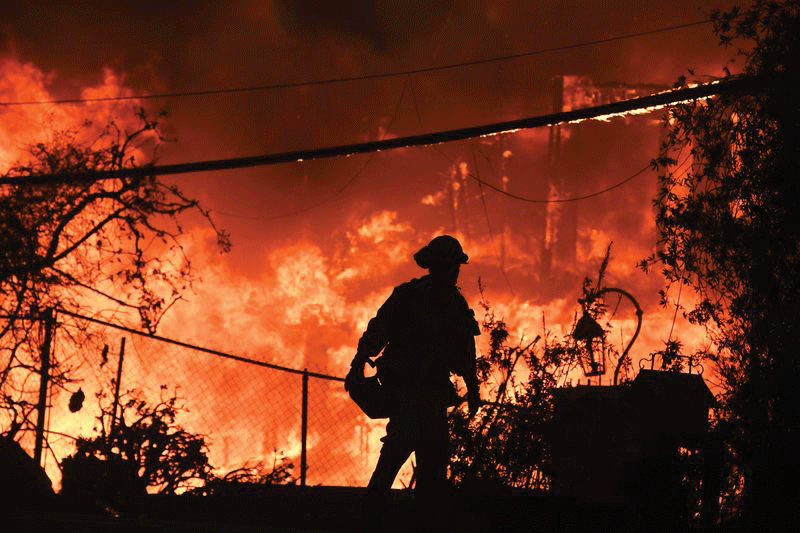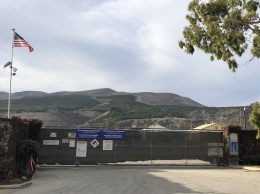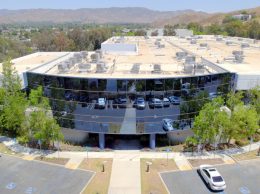PG&E, Edison stocks plummet as fires rage on
IN THIS ARTICLE
- East Ventura County Topic
- Staff Report Author
By Staff Report Monday, November 12th, 2018

A firefighter is silhouetted during the Woolsey Fire in Malibu on Nov. 9.
Updated at 10:30 a.m. Nov. 15:
PG&E and Edison continue to reel from the wildfires that have swept the state, with stock prices plummeting again Nov. 15.
PG&E shares had a second consecutive day of falling more than 20 percent. The utility has seen its stock decline by almost two-thirds in the past week, wiping off $15 billion in market value. The shares were down 26 percent at 10:20 a.m. Nov. 14 after dropping 22 percent on Nov. 14.
Officials said calmer winds Nov. 14 should help firefighters in containing the Woolsey fire, which has killed at least three people and consumed more than 98,000 acres so far. It is now 57 percent contained.
Firefighters managing the massive Woolsey fire in Ventura and Los Angeles counties will get a break in winds Thursday, which they expect will help them increase the fire’s containment, officials said.
At least 58 people have been killed from multiple wildfires in northern and southern California. Investigators are probing whether PG&E equipment ignited one of the fires. The exact cause of the fast-moving Camp Fire may not be known for months or even years.
PG&E’s potential liability if it is found responsible for this year’s fires could be as much as $15 billion, bringing the two-year total from wildfires to as much as $30 billion, Citigroup estimated. That exceeds the company’s current market value of $10.2 billion.
“The risk of bankruptcy is very real for these guys and with each passing wildfire that risk increases,” Jaimin Patel, a credit analyst for Bloomberg Intelligence, said in an interview. “They will almost certainly need help from the state.”
Updated at 10:25 a.m. Nov. 13:
The Woolsey fire in the Conejo Valley and Malibu, which had grown to 96,314 acres by the morning of Nov. 13, is now 35 percent contained.
Parts of Thousand Oaks and Westlake Village were being repopulated as evacuation warnings were lifted, but a 50-acre flare up in the Carlisle Canyon, Lake Sherwood and Boney Mountain areas prompted warnings for residents to prepare to leave.
Estimates on the number of structures destroyed swelled to 435, as the number of personnel responding to the fire neared 3,600. Cal Fire reported that the fire had scorched 83 percent of the National Parks Service land in the Santa Monica Mountains National Recreation Area.
The fire also swept through the Santa Susana Field Laboratory, but a statement released by the Department of Toxic Substances Control said that it did not believe any hazardous or radioactive materials had been released and did not anticipate any risks associated with contamination.
The nearby Hill fire was 90 percent contained and holding at around 4,500 acres, with two buildings damaged and two destroyed. A third fire that flared up to 186 acres and briefly shut down Highway 118 east of Simi Valley was fully contained.
As the Woolsey and Camp fires together burned more than 200,000 acres in Northern and Southern California, corporate donations began to pour in to help evacuees.
Thousand Oaks biotech giant Amgen announced that it would donate $500,000 through its charitable foundation to nonprofit relief efforts for the fires in Los Angeles and Ventura counties. It also pledged $250,000 to a relief fund created by the Ventura County Community Foundation for the victims of the mass shooting at the nearby Borderline Bar & Grill.
“Our community has endured significant tragedy with the recent senseless nightclub shooting, as well as another series of wildfires that have resulted in devastating damage and impact to our staff,” said Amgen Foundation Board Chair Cynthia Patton. “We are committed to assisting in relief and support efforts and applaud the firefighters and first responders who are working tirelessly to protect and serve our communities.”
The foundation also extended a matching program for donations made by its global staff for the Conejo Valley Victims Fund.
The Walmart Foundation announced that it would provide $500,000 in wildfire relief, and Facebook donated $250,000 to the American Red Cross for the Camp and Woolsey fires.
Wells Fargo also announced that it is donating $250,000 to fund wildfire relief efforts. The American Red Cross will receive $125,000, $50,000 is allocated to the United Way of Northern California, $50,000 is being granted to the Ventura County Community Foundation and $25,000 is being donated to the Los Angeles Fire Department Foundation.
The Red Cross began consolidating Ventura County evacuees Nov. 12 at the Gilbert Sports and Fitness Complex at California Lutheran University. Multiple shelters remained open in Los Angeles County.
“We are continuing to assess the needs of our community and are working closely with our government partners and other agencies to make this a smooth transition,” said Dave Maloney, disaster relief operation director. “Red Cross volunteers will continue to be in the shelter to assist families affected by the wildfires.”
Classes at CSU Channel Islands resumed Nov. 13 while classes at Pepperdine University are slated to be canceled through Thanksgiving.
Updated at 10:45 a.m. Nov. 12:
The Woolsey fire in the Conejo Valley and along the Pacific Coast Highway had grown to 91,572 acres and was 20 percent contained as of the morning of Nov. 12.
A spokesman for Cal Fire said the agency expected full containment by Nov. 15.
An estimated 370 structures had been destroyed, and 57,000 were still threatened. The nearby Hill fire had reached 80 percent containment, with only two structures destroyed and two others damaged.
More than 3,200 personnel had responded to battle the Woolsey fire, including 54 fire crews manning 450 engines, as well as 22 helicopters. Favorable conditions overnight allowed crews to reinforce containment lines, but steep terrain in the area and strong morning Santa Ana winds led to “extreme fire behavior.”
Cal Fire reported that two people had been killed in the blaze and three firefighters had been injured. The cause was still under investigation.
Two additional brush fires broke out in the East Ventura County region around 10 a.m., at Lynn Ranch and along Highway 118 at Rocky Peak, scorching around 15 acres and threatening homes and structures. First responders including ground crews and fixed-wing air support were deployed immediately to manage the new incidents.
Ventura County Fire Capt. Stan Ziegler said that it was undetermined whether the two new fires were related to the Hill or Woolsey fires.The Hll fire was 80 percent contained at around 4,500 acres on Nov. 12.
Updated at 9:30 a.m. Nov. 12:
The wildfires in northern and southern California have sent shares of the state’s two largest utility owners falling the most since the power crisis more than a decade ago.
Trading in PG&E Corp. was briefly halted Nov. 12 after shares plummeted more than 37 percent. The stock has fallen as much as 48 percent in two days of trading since the Camp Fire broke out north of San Francisco last week.
Southern California Edison lost more than a third of its value since fires broke out near Los Angeles. For both companies, the declines are among the steepest since power shortages triggered rolling blackouts across the state in 2000-2001 — a crisis that eventually forced PG&E’s utility subsidiary to file for bankruptcy protection.
Investors are concerned about utility liabilities associated with the fires. Authorities are investigating electrical equipment as one of several possible causes of the so-called Camp Fire, about 150 miles northeast of San Francisco. A PG&E transmission line in the area went offline 15 minutes before the blaze was first reported, and the company reported finding a damaged transmission tower near where investigators say the fire began.
Southern California Edison utility said Nov. 9 that a power outage occurred near the suspected starting point of one of the fires in Ventura County and that a sensor detected a disturbance in its equipment two minutes before the blaze was reported. The company said there had been no determination of origin or cause and that it will cooperate with the investigation.
The Camp Fire and the Woolsey Fire in Ventura and Los Angeles counties have destroyed more than 6,700 structures and could cost the state, insurers and homeowners at least $19 billion in damage, according to an estimate by Enki Research.
The most destructive wildfires in California’s history have killed at least 31 people and forced hundreds of thousands more to evacuate as firefighters struggle to gain control amid swirling winds.
It could take another five days before firefighters put out Woolsey and the rest of the month to extinguish the Camp Fire, the California Department of Forestry and Fire Protection, or Cal Fire, said. Meanwhile, 149,000 people remain evacuated, Mark Ghilarducci, director of California’s Office of Emergency Services., said on Nov. 11.
The blazes have now spread to more than 196,000 acres and threaten to destroy tens of thousands of structures, according to Cal Fire. About 228 people remain unaccounted for in the vicinity of the northern blaze. Gov. Jerry Brown, meanwhile, has formally asked President Donald Trump to release new federal aid in a “major disaster declaration.’’
The request for emergency funding to support housing, crisis management and infrastructure recovery efforts came a day after Trump threatened to withhold federal payments to California.
“We’re putting everything we’ve got into the fight against these fires, and this request ensures communities on the front lines get additional federal aid,” Brown said in a statement.
The damage could be on par with the type of destruction triggered by Hurricane Michael, which left Florida in disarray earlier this year, said Chuck Watson, a disaster modeler at Enki Research.
“The California fires are as bad as folks think they are,” Watson said, pegging possible damages of about $25 billion. “Insurance for fire is already becoming an issue in California and this won’t help that industry.”
Initially, Trump had threatened to withhold money because of what he called “gross mismanagement of the forests.” His later tweets were more measured, saying that “our hearts are with those fighting the fires.” On Nov. 11, Trump tweeted again to encourage “proper” management to “stop the devastation constantly going on in California.”
As of Nov. 6, all of California is abnormally dry, up from nearly 85 percent the week before, according to the U.S. Drought Monitor in Lincoln, Nebraska. Almost 52 percent of California’s land met drought definitions.
“Statewide we are in a climate change and it is going to be here for the foreseeable future,” said Daryl Osby, chief of the Los Angeles County Fire Department. “Six out of the last seven years, we’ve been in a drought.”
Updated at 3:30 p.m. Nov. 10:
The Woolsey blaze doubled overnight, having consumed 70,000 acres in Ventura and Los Angeles counties, according to Cal Fire. The Hill fire has torched about 4,500 acres in Ventura County.
Two fatalities that occurred in the fire areas are under investigation, Los Angeles County Sheriff John Benedict said during a press conference Nov. 10. At least 50 homes were lost in Ventura County, according to the sheriff’s office, and the fires forced 250,000 people to evacuate in Los Angeles and Ventura counties.
“Last night was a tough night. Mother Nature has given us a little reprieve today. It’s given us some opportunities,” Mark Lorenzen, Ventura County fire chief, said Nov. 10.
Malibu — home to Hollywood stars including Tom Hanks and Dustin Hoffman — was evacuated after flames swept south across the Santa Monica Mountains toward the sea and firefighters battled to save Pepperdine University.
It may get worse. Extreme wind conditions are forecast for Nov. 11 for a 2,510-square-mile area including Oxnard, Burbank and Simi Valley, where about 2.5 million people live, according to the U.S. Storm Prediction Center. The situation is forecast to be critical in a wider area, including Los Angeles and Anaheim, that has a population of more than 20 million.
President Trump, in Paris to celebrate the end of World War I, attributed the spread of the flames to what he called gross mismanagement of the forests.
Southern California Edison said late Nov. 9 that it had a power outage near the vicinity of the suspected starting point for the so-called Woolsey fire, according to a regulatory filing. The utility said that a sensor detected a disturbance in its equipment two minutes before the fire was first reported, according to the filing. Southern California Edison said there had been no determination of origin or cause of the wildfires and the utility will cooperate with the investigation, according to a statement.
There were also reports Nov. 11 of internet outages in East Ventura County because of fire damage.
Updated at 3:40 p.m. Nov. 9:
The Hill fire that broke out Nov. 8 in Thousand Oaks forced the evacuation of more than 45,000 people as it grew to more than 6,100 acres and threatened 437 homes, commercial properties and other infrastructure by the morning of Nov. 9.
Fueled by wind, the blaze roared across Highway 101 and swelled its footprint to thousands of acres in a matter of minutes but diminished as it moved into the footprint of the 2013 Springs fire, allowing firefighters to shift resources to the Woolsey fire, which started near Simi Valley and burned more than 14,000 acres after it crossed over Highway 101 early Nov. 9.
Evacuations were in force along the Pacific Coast Highway, and Highway 101 remained closed.
Fire officials said some homes have been destroyed but no there have been fatalities or severe injuries so far.
The Ventura County fires broke out the day after a gunman opened fire in a crowded country music bar in Thousand Oaks, killing 12.
“Many of our first responders haven’t slept,” Ventura County Second District Supervisor Linda Parks said during a news conference in Thousand Oaks. “We are still reeling, but we are also very resilient.”
Southern California Edison said it has no indication for the cause of the fire in Ventura, spokesman Robert Laffoon-Villegas said in an emailed statement.
While electrical infrastructure was listed as threatened, officials said that they had not lost any major power line infrastructure through the 101 corridor.
Acting Gov. Gavin Newsom declared a state of emergency for both events and sent a request for direct federal assistance through a presidential emergency declaration.
Ventura County Fourth District Supervisor Peter Foy urged residents in the area to heed evacuation warnings. An estimated 45,000 people remained under evacuation from Point Mugu Naval Base, California State Channel Islands, Camarillo Springs, Vallecito Trailer Park, Dos Vientos and the South Coast area.
Officials said about 85,000 homes were evacuated in Ventura and Los Angeles counties. Around 60,000 additional people were expected to be evacuated as the fire moved, said Incident Commander David Richardson.
The Los Angeles Sheriff’s Department was evacuating everyone south of Highway 101 from the Ventura County line to Topanga Canyon Boulevard, which includes basically all of Malibu. Residents were being told to evacuate via the Pacific Coast Highway, not back roads or canyon roads.
Around 2,000 personnel were engaged in the two fires, as well as dozens of engines, helicopters and air tankers as wind allowed. Agencies responded from across Southern California, Richardson said, and officials expected further help to arrive Nov. 9.
The Conejo Valley, Hueneme, Las Virgenes, Mesa Union, Oxnard, Pleasant Valley, Rio and Somis school districts had all closed for the fire, as well as several Ventura County charter schools. CSU Channel Islands was also closed Nov. 9.
Wind conditions were behaving as expected, Richardson said, pushing the fire toward the Pacific Ocean between Highway 23 and Valley Circle south of Highway 118.
The Ventura County Community Foundation has set up the Hill Fire/Woolsey Fire Sudden and Urgent Needs Effort to support the immediate needs of community nonprofit organizations serving those affected by the wildfires.
Those in need of assistance can call Stephanie Bertsch-Merbach at (805) 330-6667.
The developers of the ThomasFireHelp donations and services exchange website said it was fully deployed for the two fires and the Borderline shooting.
The site hosts categories for community members offering housing and places to evacuate animals, volunteers, supply depots where people can pick up and drop off donations, and services such as free moving or cleaning services, architects, attorneys, insurance providers, massage therapists donating their time.
The effort will also coordinate flights with volunteer pilots during the closure of Highway 101 for non-negotiable medical appointments, critical medical employees and responders.
• Contact Marissa Nall at [email protected]. Bloomberg News contributed to this report.
Related Articles
 Friday, October 14th, 2022
Friday, October 14th, 2022











